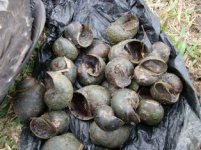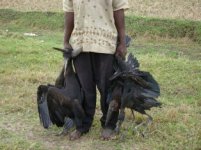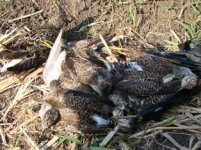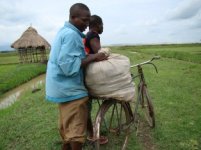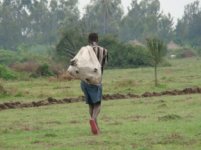Steve G
RAINBIRDER
Hi everyone,
Apologies for the length of this post but please scroll down to the images at the foot of the page to see why this needs your attention (these are our Wood Sandpipers, Ruff, etc that are being poisoned!).
I have friends in Kenya who are struggling to gain support in their campaign to persuade the Kenyan government to ban Carbofuran (Furadan). This is why they need your help:
Carbofuran (branded as Furadan) is a cholinesterase inhibitor produced in the USA by the Philadelphia-based FMC Corporation as an agricultural insecticide/nematicide. In May 2009 the U.S Enviromental Protection Agency (EPA) cancelled all food tolerances for carbofuran, an action which amounts to a de facto ban on its use on all crops grown for human consumption, this being brought about due to human toxicity issues and mass bird poisonings. Here is a link to the EPA website which justifies their stance: http://www.epa.gov/pesticides/reregistration/carbofuran/carbofuran_noic.htm
If the name carbofuran sounds familiar to UK birders that’s because it is the favoured substance used in baits to poison our raptors (check how many times the chemical is mentioned in table 1 of this link): http://docs.google.com/gview?a=v&q=...FNbKoY&sig=AFQjCNERquylYi5hCgrZAmA6MG6X0HNIAQ
Unfortunately Furadan is widely available in most African countries including Kenya where it is offloaded cheaply & where it has, to date, escaped safety restrictions or limitations of use (in no small part due to unofficial “political donations”!). Furadan is available very cheaply in Kenya and can even be purchased in small local stores. Though promoted as a crop insecticide/nematicide it is now frequently used to kill birds.
Furadan has been used by herdsmen to lace poison baits specifically to kill lions but it has also caused the death of hundreds of vultures. It is now also being used by subsistence hunters to "hunt" birds for the bushmeat trade. It is this latter use which has become especially worrying as birds are being killed in their thousands (this includes large numbers of storks and palearctic waders). The carcases are sold on as bushmeat in markets without due care taken to ensure the chemical is purged from the meat raising the very strong possibility of poisoning in the consumer.
As an example of how Furadan is now being used to “hunt” birds here is a short article written by Martin Odino for Nature Kenya’s online magazine called “Where Furadan Kills all Birds”:
“Bunyala Rice Scheme is situated in western Kenya North West of Lake Victoria near the Kenya-Uganda border. Like many irrigation schemes, it throbs with bird life whose numbers swell even more during the migration period. In fact this area is on the flyway that is used by Palearctic migrants. So rich is the avifauna that virtually all birds from various habitats are represented; Terns, Herons, Storks, Nightjars, Eagles, Starlings, Crows, Pipits and Sunbirds, occur in their various species.
But death lurks behind these beautiful creatures all year round and thousands are poisoned every week. Bird meat is a delicacy amongst the locals of Bunyala. The method used to capture the birds is however crude and brutal. It involves use of the pesticide Furadan which is a carbamate nematicide and therefore an acetylcholinesterase inhibitor. The poison pesticide is locally available in granular form; it is these granules that are laced on the various birds’ baits which are then laid out where birds forage in and around the irrigation scheme.
A modification of the baiting involves employing live decoys alongside the poison laced baits. This is particularly so for the African Open-billed Stork. Mildly intoxicated storks are captured and given plenty of water to revive them. These are then kept captive which involves the pulling off of their flight feathers and tying their legs together with a loose string to limit their free movement. These decoys are usually set out on an open field with the poison bait scattered about. Acting as attractants to conspecific members, the others fly in as the poachers (the people that poison the birds) disturb any nearby foraging birds so that they take to flight. Once airborne, they will notice the captives and deceived that they are other free birds settled where there is food settle down as well to feed on the poison bait.
Once intoxicated the birds are disoriented and walk in staggering gait. The poachers then batter them with sticks and pack them in sacks and load them on bicycles taking them to homesteads and markets where they will sell them for human consumption.”
Carbofuran is toxic to humans and indeed the three year old son of a Kenyan teacher recently died as a result of accidental poisoning. His father, an educated man, was not aware of the dangers of Furadan (he had bought it to use on the family's vegetable plot) as the packaging does not bear the skull & cross bones warning sign -which is the universal international sign of a poison!
Furadan is now both cheap and widely available in many African countries where it is supplied in granular form. Should its use become more frequent across the numerous small agricultural plots of Africa then less of our summer migrants such as redstarts, whinchat, wheatears and nightingales will make the journey north each spring!!!
In short we need a worldwide ban of carbofuran!
When I suggested to friends in Kenya that we raise a petition on this issue the reply was: “A petition has little clout in Kenya where high government officials are under Ocampo's gun for impunity and the massacre of over 1000 people. Here cause and effect are difficult to link.”
The best way to help this cause is to publicise it and to support the work of Wildlife Direct by visiting their blog to read about the problems created by Carbofuran at first hand (it smacks of John le Carré’s The Constant Gardener!) and, if you are able, donate to the cause. Please visit the blog at: http://stopwildlifepoisoning.wildlifedirect.org/
Many thanks for reading this.
Best wishes,
Steve
Apologies for the length of this post but please scroll down to the images at the foot of the page to see why this needs your attention (these are our Wood Sandpipers, Ruff, etc that are being poisoned!).
I have friends in Kenya who are struggling to gain support in their campaign to persuade the Kenyan government to ban Carbofuran (Furadan). This is why they need your help:
Carbofuran (branded as Furadan) is a cholinesterase inhibitor produced in the USA by the Philadelphia-based FMC Corporation as an agricultural insecticide/nematicide. In May 2009 the U.S Enviromental Protection Agency (EPA) cancelled all food tolerances for carbofuran, an action which amounts to a de facto ban on its use on all crops grown for human consumption, this being brought about due to human toxicity issues and mass bird poisonings. Here is a link to the EPA website which justifies their stance: http://www.epa.gov/pesticides/reregistration/carbofuran/carbofuran_noic.htm
If the name carbofuran sounds familiar to UK birders that’s because it is the favoured substance used in baits to poison our raptors (check how many times the chemical is mentioned in table 1 of this link): http://docs.google.com/gview?a=v&q=...FNbKoY&sig=AFQjCNERquylYi5hCgrZAmA6MG6X0HNIAQ
Unfortunately Furadan is widely available in most African countries including Kenya where it is offloaded cheaply & where it has, to date, escaped safety restrictions or limitations of use (in no small part due to unofficial “political donations”!). Furadan is available very cheaply in Kenya and can even be purchased in small local stores. Though promoted as a crop insecticide/nematicide it is now frequently used to kill birds.
Furadan has been used by herdsmen to lace poison baits specifically to kill lions but it has also caused the death of hundreds of vultures. It is now also being used by subsistence hunters to "hunt" birds for the bushmeat trade. It is this latter use which has become especially worrying as birds are being killed in their thousands (this includes large numbers of storks and palearctic waders). The carcases are sold on as bushmeat in markets without due care taken to ensure the chemical is purged from the meat raising the very strong possibility of poisoning in the consumer.
As an example of how Furadan is now being used to “hunt” birds here is a short article written by Martin Odino for Nature Kenya’s online magazine called “Where Furadan Kills all Birds”:
“Bunyala Rice Scheme is situated in western Kenya North West of Lake Victoria near the Kenya-Uganda border. Like many irrigation schemes, it throbs with bird life whose numbers swell even more during the migration period. In fact this area is on the flyway that is used by Palearctic migrants. So rich is the avifauna that virtually all birds from various habitats are represented; Terns, Herons, Storks, Nightjars, Eagles, Starlings, Crows, Pipits and Sunbirds, occur in their various species.
But death lurks behind these beautiful creatures all year round and thousands are poisoned every week. Bird meat is a delicacy amongst the locals of Bunyala. The method used to capture the birds is however crude and brutal. It involves use of the pesticide Furadan which is a carbamate nematicide and therefore an acetylcholinesterase inhibitor. The poison pesticide is locally available in granular form; it is these granules that are laced on the various birds’ baits which are then laid out where birds forage in and around the irrigation scheme.
A modification of the baiting involves employing live decoys alongside the poison laced baits. This is particularly so for the African Open-billed Stork. Mildly intoxicated storks are captured and given plenty of water to revive them. These are then kept captive which involves the pulling off of their flight feathers and tying their legs together with a loose string to limit their free movement. These decoys are usually set out on an open field with the poison bait scattered about. Acting as attractants to conspecific members, the others fly in as the poachers (the people that poison the birds) disturb any nearby foraging birds so that they take to flight. Once airborne, they will notice the captives and deceived that they are other free birds settled where there is food settle down as well to feed on the poison bait.
Once intoxicated the birds are disoriented and walk in staggering gait. The poachers then batter them with sticks and pack them in sacks and load them on bicycles taking them to homesteads and markets where they will sell them for human consumption.”
Carbofuran is toxic to humans and indeed the three year old son of a Kenyan teacher recently died as a result of accidental poisoning. His father, an educated man, was not aware of the dangers of Furadan (he had bought it to use on the family's vegetable plot) as the packaging does not bear the skull & cross bones warning sign -which is the universal international sign of a poison!
Furadan is now both cheap and widely available in many African countries where it is supplied in granular form. Should its use become more frequent across the numerous small agricultural plots of Africa then less of our summer migrants such as redstarts, whinchat, wheatears and nightingales will make the journey north each spring!!!
In short we need a worldwide ban of carbofuran!
When I suggested to friends in Kenya that we raise a petition on this issue the reply was: “A petition has little clout in Kenya where high government officials are under Ocampo's gun for impunity and the massacre of over 1000 people. Here cause and effect are difficult to link.”
The best way to help this cause is to publicise it and to support the work of Wildlife Direct by visiting their blog to read about the problems created by Carbofuran at first hand (it smacks of John le Carré’s The Constant Gardener!) and, if you are able, donate to the cause. Please visit the blog at: http://stopwildlifepoisoning.wildlifedirect.org/
Many thanks for reading this.
Best wishes,
Steve




